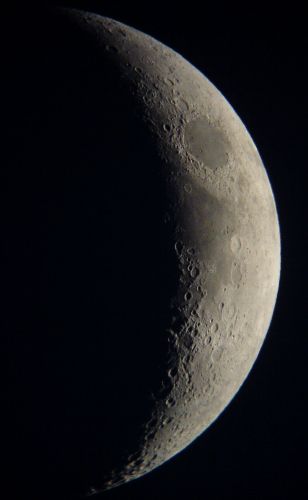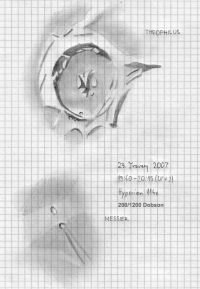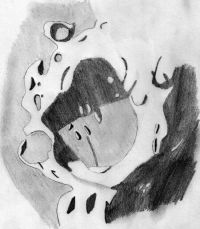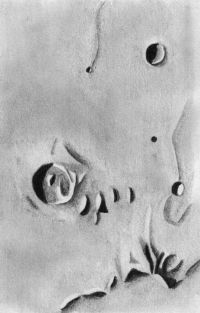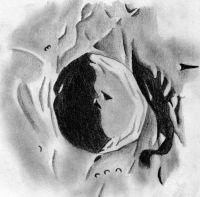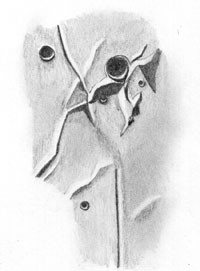
| MOON |
|---|
The Moon is Earth's only natural satellite. The average centre-to-centre distance from the Earth to the Moon is 384,403 kilometres, which is about 30 times the diameter of the Earth. The Moon has a diameter of 3,474 kilometres— slightly more than a quarter that of the Earth. This means that the volume of the Moon is only 1/50th that of Earth. The gravitational pull at its surface is about a 1/6th of Earth's. The Moon makes a complete orbit around the Earth every 27.3 days, and the periodic variations in the geometry of the Earth–Moon–Sun system are responsible for the lunar phases that repeat every 29.5 days. The gravitational attraction, and the centrifugal forces generated by the rotation of the Moon and Earth around a common axis, the barycentre, is largely responsible for the tides on Earth. The energy dissipated in generating tides is directly responsible for the reduction in potential energy in the Moon-Earth orbit around the barycentre, resulting in a 3.8 cm yearly increase in the distance between the two bodies.The Moon will continue to move slowly away from the Earth until the tidal effects between the two are no longer of significance, whereupon the Moon's orbit will stabilise. The Moon is the only celestial body that humans have travelled to and landed on. The first artificial object to escape Earth's gravity and pass near the Moon was the Soviet Union's Luna 1, the first artificial object to impact the lunar surface was Luna 2, and the first photographs of the normally occluded far side of the Moon were made by Luna 3, all in 1959. The first spacecraft to perform a successful lunar soft landing was Luna 9 and the first unmanned vehicle to orbit the Moon was Luna 10, both in 1966.The U.S. Apollo program has achieved the first (and only) manned missions to date, resulting in six landings between 1969 and 1972. Human exploration of the Moon ceased with the conclusion of the Apollo program, although as of 2007, several countries have announced plans to send either people or robotic spacecraft to the Moon. On 4 December 2006, NASA outlined plans for a permanent base on the Moon as part of preparation for a voyage to Mars. Construction of the base is scheduled to take about five years, with the first preliminary missions by 2020. |
|
The Moon is in synchronous rotation, meaning that it keeps nearly the same face turned away from Earth at all times. Early in the Moon's history, its rotation slowed and became locked in this configuration as a result of frictional effects associated with tidal deformations caused by the Earth.Nevertheless, small variations resulting from the eccentricity of the lunar orbit, termed librations, allow about 59 percent of the lunar surface to be viewed from Earth. The side of the Moon that faces Earth is called the near side, and the opposite side the far side. The far side should not be confused with the dark side, which is the hemisphere that is not being illuminated by the Sun at a given moment. The far side of the Moon was first photographed by the Soviet probe Luna 3 in 1959. One distinguishing feature of the far side is its almost complete lack of maria.The dark and relatively featureless lunar plains humans can clearly see when the Moon is full are called maria (singular mare), Latin for seas, since they were believed by ancient astronomers to be filled with water. Nearly all of these are actually vast solidified pools of ancient basaltic lava. The erupting lava flowed into the depressions formed by colliding meteors / comets, the impact basins. (Oceanus Procellarum is a major exception in that it does not correspond to a known impact basin). Maria are found almost exclusively on the near side of the Moon, with the far side having only a few scattered patches covering only about 2% of its surface,compared with about 31% on the near side. The lighter-colored regions of the Moon are called terrae, or more commonly just highlands, since they are higher than most maria. Several prominent mountain ranges on the near side are found along the periphery of the giant impact basins, many of which have been filled by mare basalt. These are believed to be the surviving remnants of the impact basin's outer rims.In contrast to the Earth, no major lunar mountains are believed to have formed as a result of tectonic events. From images taken by the Clementine mission, it appears that four mountainous regions on the rim of the 73-km-wide (45-mi-wide) Peary crater at the Moon's north pole remain illuminated for the entire lunar day. These peaks of eternal light are possible because of the Moon's extremely small axial tilt to the ecliptic plane. No similar regions of eternal light were found at the south pole, although the rim of Shackleton crater is illuminated for about 80% of the lunar day. Another consequence of the Moon's small axial tilt is regions that remain in permanent shadow at the bottoms of many polar craters. The Moon's surface shows obvious evidence of having been affected by impact cratering. Impact craters form when asteroids and comets collide with the lunar surface, and globally about half a million craters with diameters greater than one kilometre (0.6 miles) can be found. Since impact craters accumulate at a nearly constant rate, the number of craters per unit area superposed on a geologic unit can be used to estimate the age of the surface (see crater counting). The lack of an atmosphere, weather and recent geological processes ensures that many of these craters have remained relatively well preserved in comparison to those found on Earth. The largest crater on the Moon, which also has the distinction of being the largest known crater in the Solar System, is the South Pole-Aitken basin. This impact basin is located on the far side, between the South Pole and equator, and is some 2,240 kilometres (1,390 miles) in diameter and 13 kilometres (8 miles) in depth. Prominent impact basins on the near side include Imbrium, Serenitatis, Crisium, and Nectaris. |
|
|
|
VEDRAN VRHOVAC© 2006.-2007. |
